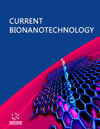- Home
- A-Z Publications
- Current Bionanotechnology (Discontinued)
- Previous Issues
- Volume 1, Issue 2, 2015
Current Bionanotechnology (Discontinued) - Volume 1, Issue 2, 2015
Volume 1, Issue 2, 2015
-
-
Aptamer-Quantum Dot Lateral Flow Test Strip Development for Rapid and Sensitive Detection of Pathogenic Escherichia coli via Intimin, O157- Specific LPS and Shiga Toxin 1 Aptamers
More LessAuthors: John G. Bruno and Alicia RicharteBackground: The use of DNA aptamers to replace antibodies in lateral flow (LF) test strip assays coupled to quantum dots (QDs) has demonstrated enhanced sensitivity for the rapid and portable detection of several foodborne pathogenic bacterial species with simple ultraviolet (UV) illumination and visual assessment (Bruno, Pathogens, 2014; 3: 341-355). Objectives: The present report extends and focuses development on detec Read More
-
-
-
Microwave Assisted Biogenic Synthesis of Metal Nanoparticles Using Plant Extract: Characterization and Antimicrobial Activity
More LessAuthors: Kuntal Manna, Waikhom Somraj Singh, Lipika Das, Marina Reang, Manik Das and Debasish MaitiBackground: The present study deals with new microwave assisted green, costeffectiveness, synthesis of metal nanoparticles using aqueous leaf extracts. The plant extracts with metal precursors were used to made eco-friendly/ biodegradable metal nanoparticles through conventional and microwave irradiated methods. The iron and silver nanoparticles are one of them. Methods: Synthesized AgNPs and FeNPs were primaril Read More
-
-
-
Novel Aqueous Fabrication and Characterization of Gold Coated Cobalt Nanoparticles
More LessBackground: Biological applications such as imaging and targeted drug delivery and many others require non-toxic, stable, inert and biocompatible nanoparticles. Coating the nanoparticles with inert materials is one of the ways that is used to enhance the stability and biocompatibility of nanoparticles. In particular, gold coating is very attractive as it reduces the toxicity of the magnetic nanoparticles, enhances their stabilit Read More
-
-
-
Use of DNA Stabilizers to Extend Plasmid Biological Activity
More LessAuthors: Jonathan De la Vega, Gabriel A. Monteiro and Duarte Miguel F. PrazeresBackground: Storage stability of plasmid biopharmaceuticals is a critical issue that needs to be addressed during clinical and process development. Objectives: The goal of this work was to evaluate the ability of stabilizers to prolong the stability of plasmid DNA solutions and extend the duration of transgene expression of transfected cells. Methods: A plasmid harboring the GFP gene and Chinese Hamster Ovary (CHO) cells were Read More
-
-
-
Effect of Perfluorinated-Hexaethylene Glycol Functionalization of Gold Nanoparticles on the Enhancement of the Response of an Enzymatic Conductometric Biosensor for Urea Detection
More LessIn conductometric enzymatic biosensors, enzymatic reaction is confined close to the interdigitated electrode surface, because enzyme is cross-linked in contact with this surface in the presence or absence of nanoparticles. The effect of the use of a new type of doubly-functionalized gold nanoparticles (PF-HEG-Au NPs) on the response of conductometric biosensor based on interdigitated electrodes (IDEs), for the detection Read More
-
-
-
Proteomic Investigations on Interaction of Silver Nanoparticles with Halophilic Bacillus sp. EMB9
More LessAuthors: Rajeshwari Sinha, R. Hemamalini and S. K. KhareBackground: With the recent advances of nanotechnological interventions, nanoparticles have found immense importance in various sectors of water, energy, health, agriculture and environment. Concurrently, there has been an increasing concern about their toxicity on living systems. The bactericidal role of silver nanoparicle is well established. The present work explores the interaction of silver nanoparticles with halophilic Read More
-
-
-
Antimicrobial Surfaces from Incorporated Nano-agents
More LessAuthors: Sofía Municoy, Martin F. Desimone, Paolo N. Catalano and Martin G. BellinoBiofilm development is a survival strategy for majority of bacteria to adapt to their living environment. These biofilms are prevalent on most surfaces in nature. Microbial cells in biofilm exhibit significantly enhanced tolerance and resistance to antimicrobial challenge and host defenses. Therefore, the control and eradication of biofilm-associated diseases present a great challenge. Recently, there is considerable biomedi Read More
-
Volumes & issues
Most Read This Month
Article
content/journals/cbnt
Journal
10
5
false
en


